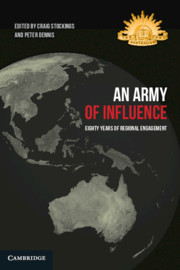Book contents
- An Army of Influence
- Acknowledgement of Country
- An Army of Influence
- Copyright page
- Foreword
- Contents
- Figures, maps and tables
- Contributors
- Abbreviations
- Introduction
- Part 1 The concept of an army’s influence abroad
- Part 2 Lessons from past relationships
- Part 3 Ongoing relationships
- Chapter 9 Access, but how much influence?
- Chapter 10 Australia’s military engagement with Malaysia, 1955–2020
- Chapter 11 Cambodia
- Chapter 12 Was the juice worth the squeeze?
- Chapter 13 Achieving influence through advising relationships
- Chapter 14 Training teams as a force of choice
- Chapter 15 A perspective on diplomacy in the Army’s contemporary regional relationship-building
- Chapter 16 The Army’s patchy engagement with Australia’s near north
- Index
Chapter 12 - Was the juice worth the squeeze?
Australian Defence Force investment in nation-building in Bougainville and Solomon Islands
from Part 3 - Ongoing relationships
Published online by Cambridge University Press: 16 November 2021
- An Army of Influence
- Acknowledgement of Country
- An Army of Influence
- Copyright page
- Foreword
- Contents
- Figures, maps and tables
- Contributors
- Abbreviations
- Introduction
- Part 1 The concept of an army’s influence abroad
- Part 2 Lessons from past relationships
- Part 3 Ongoing relationships
- Chapter 9 Access, but how much influence?
- Chapter 10 Australia’s military engagement with Malaysia, 1955–2020
- Chapter 11 Cambodia
- Chapter 12 Was the juice worth the squeeze?
- Chapter 13 Achieving influence through advising relationships
- Chapter 14 Training teams as a force of choice
- Chapter 15 A perspective on diplomacy in the Army’s contemporary regional relationship-building
- Chapter 16 The Army’s patchy engagement with Australia’s near north
- Index
Summary
Australia has heavily invested in peacemaking and nation-building across the Pacific, especially in Bougainville and Solomon Islands, where, in financial terms alone, it has directed over $4.1 billion in overseas development aid since 1991. The Australian Defence Force (ADF) has played a critical role in delivering on Australia’s foreign policy objectives in both of these places, most visibly through major, majority-ADF-funded, pan-Pacific coalition operations like the Truce Monitoring Group (TMG) and Peace Monitoring Group (PMG) (Operations Bel Isi and Bel Isi II) in Bougainville between 1997 and 2003, and through its contribution to the Regional Assistance Mission to Solomon Islands (RAMSI) (Operation Anode) from 2003 to 2013. More recently, some commentators have suggested that the goodwill capital generated through these ADF commitments has been eroded by Australia neglecting its Pacific neighbours. Australia has seemingly also been blindsided by the conflation of two contemporary geopolitical issues – namely, a rise in China’s regional influence and concerns voiced across the Pacific Islands Forum at Australia’s perceived inaction on climate change.
- Type
- Chapter
- Information
- An Army of InfluenceEighty Years of Regional Engagement, pp. 267 - 299Publisher: Cambridge University PressPrint publication year: 2021



